Otterhounds shed moderately. Their thick, rough, double coat is designed for water resistance and sheds regularly, but not excessively, compared to some other breeds. However, they do experience heavier shedding periods, especially during seasonal changes (spring and fall). Regular brushing a couple of times per week helps manage shedding and prevents their coat from becoming matted. This also reduces the amount of loose hair around the house.
Otterhound
Breed Type: Hound
Common nicknames: Otterhound
Coat: Rough, double
Hypoallergenic: No, they will likely trigger allergies.
Temperament: Loving, friendly, playful, energetic
Life expectancy: 10-13 years
Color & patterns: Black and tan

The Otterhound is an excellent choice for those seeking a friendly and adventurous pup. With their shaggy coats and expressive eyes, these dogs possess a distinctive charm that captures hearts. Otterhounds are known for their playful and outgoing nature, making them great family pets and social companions. Otterhounds are intelligent and trainable, although they can have an independent streak. Their love for the outdoors and their exceptional sense of smell make them excellent trackers and scent hounds. If you’re looking for a lovable and active pal who brings positive vibes, the Otterhound is sure to do just that.
Otterhound characteristics
Learn about about Otterhound basics like their fur colors, shedding levels, how much grooming they need, and other Otterhound facts.
Average height
24-27 inches (61.0-68.6cm)
Average weight
58-118 pounds (26.3-53.5 kg)
Average lifespan
10-13 years
Exercise needs
Grooming needs
Full-grown size
Good with cats
Good with kids
Training Aptitude
What is the average lifespan of an Otterhound?
The average lifespan of an Otterhound is typically around 10 to 13 years. Like many breeds, their lifespan can vary based on factors such as genetics, diet, exercise, and overall health care. Regular vet checkups and good care can help them live a longer, healthier life.
When do Otterhounds stop growing?
Otterhounds stop growing around 18 to 24 months of age. They are a large breed, and their growth can be gradual, with their full physical development continuing into their second year. During this time, they can still gain muscle and fill out, even if they’ve reached their full height.
How big do Otterhounds get?
Otterhounds are a large breed. Males are about 27 inches tall at the shoulder, while females are slightly smaller, around 24 inches tall. Males usually weigh 115 pounds on average, and females typically weigh 80 pounds.
Do Otterhounds have webbed feet?
Yes, Otterhounds have webbed feet. This feature is one of the reasons they are excellent swimmers, as they were originally bred for hunting otters in the water. Their webbed feet, along with their strong, muscular build and thick, water-resistant coat, make them well-suited for navigating through water with ease.
What colors do Otterhounds come in?
Otterhounds can be a variety of colors, including black, black and tan, blue and cream, gray, liver and tan, tan, wheaten, blue, lemon, black, and white, black, and tan.
Otterhound history
Learn about where this Otterhound came from!
Why are Otterhounds so rare?
Otterhounds are rare today for a few reasons. They were originally bred for a very specific task, hunting otters, which is not common now due to changes in hunting regulations and practices. As the demand for their hunting skills decreased, so did their numbers. Additionally, their distinctive needs and characteristics, such as their large size and high exercise requirements, make them less popular compared to some other breeds.
Where are Otterhounds from?
Otterhounds are from England. They were developed in the 11th century to hunt otters. Their history is quite rich and closely tied to hunting and working alongside humans in England.
What were Otterhounds bred for?
Otterhounds were bred primarily for hunting otters. They have a keen sense of smell, strong swimming ability, and a rugged, water-resistant coat that makes them well-suited for tracking and pursuing otters in various types of terrain, including rivers.
Otterhound temperament
Learn about about the Otterhound temperament and how well they fit into your lifestyle, home environment, and family.
Do Otterhounds make good pets?
Yes, Otterhounds make good pets, but they are not the best fit for every household. Otterhounds are loving and friendly. They tend to get along well with family members, including children, and are usually good with other dogs. They have a playful spirit and love outdoor activities, making them great companions for active families that enjoy hiking or swimming.
Otterhounds are large, active dogs that need plenty of physical exercise. Without enough activity, they can become bored and potentially destructive. Due to their size and energy levels, they are better suited for homes with a yard rather than apartments. Being scent hounds, they have a strong drive to follow their noses and might wander off, so a secure yard or leash is essential.
Do Otterhounds bark a lot?
Yes, Otterhounds bark a lot. Their loud, deep bark is used to communicate long distances during hunting. They might bark at unfamiliar sights, sounds, or visitors, though they are not typically aggressive or considered guard dogs. Otterhounds can also bark out of boredom if they don’t get enough exercise or mental stimulation. Proper training and adequate exercise can help minimize excessive barking. However, they may not be ideal for environments where excessive noise could be an issue.
Are Otterhounds good family dogs?
Yes, Otterhounds are good family dogs, especially for families that are active and can meet their needs. Otterhounds enjoy being around people and are known to bond closely with their families. They are typically patient and playful, making them good companions for children. Otterhounds love to be involved in family fun. Their size and energy match well with active families who enjoy outdoor activities like hiking, running, or swimming.
Are Otterhounds easy to train?
No, Otterhounds are not easy to train. They are generally challenging to train due to their independent and sometimes stubborn nature. While they are intelligent and capable of learning, their strong prey drive and hunting instincts can make them less responsive to training compared to some other breeds. Consistent, firm, and positive reinforcement training methods work best. Repetition and clear communication are key. However, keep in mind that training any dog takes substantial time and effort, regardless of breed.
Are Otterhounds smart?
Yes, Otterhounds are smart dogs, but their intelligence can manifest differently compared to more conventional breeds. They are clever and have strong problem-solving skills, especially when it comes to using their noses for tracking and scent work. However, their intelligence is coupled with an independent streak and strong prey drive, which can sometimes make training a bit more challenging.
Are Otterhounds friendly?
Yes, Otterhounds are friendly and affectionate. They tend to be warm and social with people and enjoy spending time with their family members, forming strong bonds with them. They have a playful spirit and are often enthusiastic about activities, making them fun and engaging pets.
Can Otterhounds be left alone?
Yes, Otterhounds can be left alone for short periods, but they are generally not suited for long hours of solitude. Otterhounds are social dogs that thrive on interaction and companionship. Long periods of isolation can lead to boredom and anxiety, potentially resulting in destructive behavior. They need regular exercise to stay physically and mentally stimulated. If left alone for too long without adequate activity, they might become restless or engage in problematic behaviors.
If you need to leave your Otterhound alone, start with short periods and gradually increase the time while ensuring they have engaging toys or food puzzles. If possible, having another dog or a pet sitter can help alleviate loneliness and provide some company while you’re away.
Are Otterhounds good with kids?
Yes, Otterhounds are good with kids, particularly in active households. They are affectionate, gentle, and usually patient with children. Their playful demeanor and energy level match well with kids who love to run, play, and engage in outdoor activities.
Otterhounds are large dogs, which means they might unintentionally knock over smaller children, especially when excited or playful. As with any large breed, it’s important to supervise interactions between an Otterhound and young children to ensure safe and respectful play. Teaching children how to properly approach and handle dogs is crucial to ensure positive experiences for both the dog and the child, as is teaching dogs how to interact gently with children.
Are Otterhounds good with other dogs?
Yes, Otterhounds are good with other dogs in general. As a breed that historically hunted in packs, Otterhounds have a natural inclination to get along well with other dogs. They are typically friendly and enjoy interacting with other dogs. Their social nature often makes them good companions in a multi-dog household.
Due to their strong prey drive, Otterhounds may sometimes exhibit chase behavior, especially with smaller or fast-moving dogs. This is something to monitor and manage. Proper socialization from a young age is important. Exposing them to various dogs in different settings will help them develop good social skills and reduce any potential issues.
Are Otterhounds good with cats?
Yes, Otterhounds can potentially be good with cats, but it largely depends on the individual dog and how the pets are introduced. Being scent hounds with a strong prey drive, Otterhounds might instinctively chase smaller animals like cats. However, with proper training and socialization, many Otterhounds can coexist peacefully with cats. Otterhounds who are raised with cats from a young age are more likely to see them as part of the family rather than something to chase.
Otterhound health
Learn about about the Otterhound health outlook and what diseases they may be prone to at various stages of their life.
What are the health issues with Otterhounds?
Otterhounds are generally a robust and healthy breed, but like all dogs, they can be prone to certain health issues. Here are some common health concerns to be aware of with Otterhounds:
Hip dysplasia: This genetic condition involves abnormal development of the hip joint, which can lead to arthritis and pain.
Ear infections: Their floppy, long ears can trap moisture and debris, making them prone to ear infections. Regular ear cleaning and inspections are important to prevent infections.
Bloat (gastric dilatation-volvulus): This is a serious condition in which the stomach fills with gas and twists, which is life-threatening.
Eye conditions: Otterhounds are prone to certain eye conditions, such as cataracts.
Hypothyroidism: This is a condition where the thyroid gland does not produce enough thyroid hormone, leading to symptoms like weight gain, lethargy, and skin problems. It can be managed with medication.
Obesity: Due to their large size and love of food, Otterhounds are prone to obesity. Maintaining a balanced diet and regular exercise is crucial to avoid this issue.
Are Otterhounds hypoallergenic?
Otterhounds are not hypoallergenic. Their dense, double-coat sheds and can also trap dander, which can trigger allergies in sensitive individuals.
Do you need to groom an Otterhound?
Yes, you need to groom an Otterhound. They are not high-maintenance compared to some other breeds, but consistent grooming is essential. They should be brushed at least two to three times per week to prevent mats and tangles. During shedding seasons, more frequent brushing might be needed to remove loose hair.
Otterhounds have an oily coat, which helps waterproof them for swimming, but it can cause a distinct “hound” odor. Occasional bathing will keep their coat clean and help cut down on the smell. Their long, floppy ears are prone to infections, so clean and inspect them regularly.
Find Otterhound puppies near you
Adopting an Otterhound
We don't see any Otterhounds available for adoption in your exact location or cities near you, but here are some adorable similar breeds in Columbus, OH.
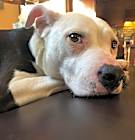
Penny
American Pit Bull Terrier Mutt
Female, adult
Westerville, OH
Not good with dogs
Not good with cats
House-trained
Spayed or Neutered
Shots are up-to-date
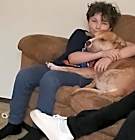
Lucky
Mutt Labrador Retriever
Male, adult
Westerville, OH
Good with dogs
Not good with cats
House-trained
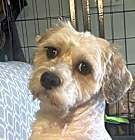
Barry
Shih Tzu Bichon Frise
Male, 5 yrs 9 mos
Westerville, OH
Not good with dogs
Not good with cats
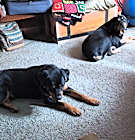
Henry and Raaz
Rottweiler
Male, adult
Westerville, OH
Not good with dogs
Not good with cats
Needs experienced adopter
House-trained
Spayed or Neutered
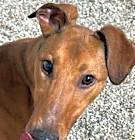
Pudge
Greyhound Hound (Unknown Type)
Female, 3 yrs 7 mos
Westerville, OH
Not good with dogs
Not good with cats
Spayed or Neutered
Shots are up-to-date

Woody
Greyhound Hound (Unknown Type)
Male, adult
Westerville, OH
Good with dogs
Not good with cats
Spayed or Neutered
Shots are up-to-date
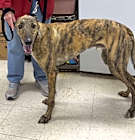
Reacher
Greyhound Hound (Unknown Type)
Male, 3 yrs 6 mos
Westerville, OH
Good with dogs
Not good with cats
Spayed or Neutered
Shots are up-to-date
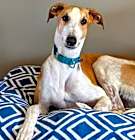
Pepper Jack
Greyhound Coonhound (Unknown Type)
Male, 2 yrs 6 mos
Westerville, OH
Good with dogs
Not good with cats
House-trained
Spayed or Neutered
Shots are up-to-date

Penny
American Pit Bull Terrier Mutt
Female, adult
Westerville, OH
Not good with dogs
Not good with cats
House-trained
Spayed or Neutered
Shots are up-to-date

Lucky
Mutt Labrador Retriever
Male, adult
Westerville, OH
Good with dogs
Not good with cats
House-trained

Barry
Shih Tzu Bichon Frise
Male, 5 yrs 9 mos
Westerville, OH
Not good with dogs
Not good with cats

Henry and Raaz
Rottweiler
Male, adult
Westerville, OH
Not good with dogs
Not good with cats
Needs experienced adopter
House-trained
Spayed or Neutered

Pudge
Greyhound Hound (Unknown Type)
Female, 3 yrs 7 mos
Westerville, OH
Not good with dogs
Not good with cats
Spayed or Neutered
Shots are up-to-date

Woody
Greyhound Hound (Unknown Type)
Male, adult
Westerville, OH
Good with dogs
Not good with cats
Spayed or Neutered
Shots are up-to-date




